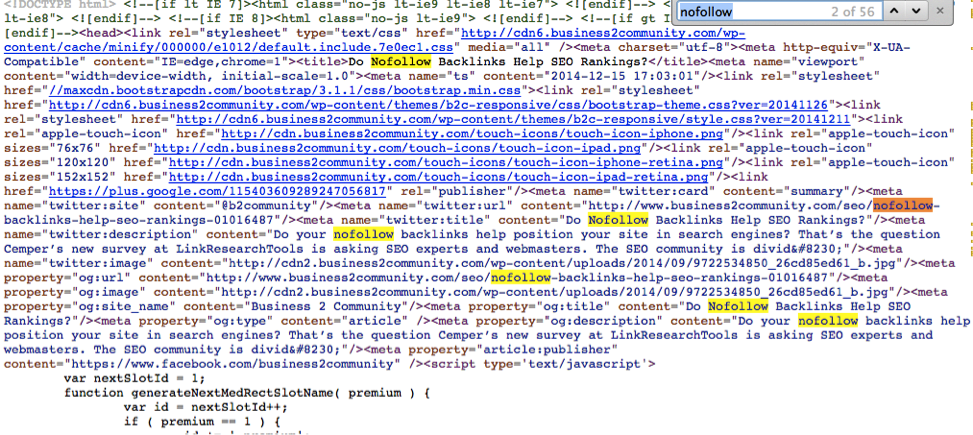It’s no secret that link building has changed quite a bit over the last few years, but one thing that hasn’t changed much is nofollow linking. For a while companies never wanted a nofollow link because it wasn’t as good as a dofollow link, but now that more and more websites are cracking down on external links and Google is keeping close tabs on companies that are trying to build links for SEO purposes, nofollow links don’t seem so bad. In fact, they should be looking very good right about now, and that’s only going to become more true as we head into the New Year.
How NoFollow Links Work and The Benefits
For those who are unfamiliar, a nofollow link works exactly the way you would assume—it means that a company earns a link, but it isn’t going to be followed by the Google bots. In other words, the link won’t count toward any link juice for SEO benefits or for any PR purposes. The link is there for readers to click to learn more information, and that’s it.
It might not sound too great at first, but there are actually quite a few benefits that come from having a nofollow link pointing back to your website:
-
Users can still click the links.
This is of course a big way to bring traffic to your site. If someone is reading an article and wants to learn more, having that link there is an opportunity to drive someone to your website.
-
It helps your audience.
It’s important to always remember that when you’re writing you need to be writing for your readers first and for the search engine bots second. If you have an article or a resource on your website that can help your audience, it shouldn’t matter whether it’s dofollow or nofollow. This is another way to show your credibility and improve your reputation amongst the community.
-
You have more opportunities with larger publications.
Many larger publications online do not accept guest contributions because they do not want to be bothered with people writing only for link building opportunities. If you show that the link is the least of your worries by saying that you are happy with dofollow links, you may get more opportunities to publish and therefore more opportunities to get your content in front of the eyes of a larger audience.
-
Improved link variety.
To make something clear, it’s no longer recommended you get your dofollow links on a large variety of websites (instead you should be focusing on getting a lot of backlinks on a few authortitative sites). However, diversifying your link profile between nofollow and dofollow is encouraged. This helps your company appear more natural to Google. In my opinion, this is going to be a bigger ranking factor in the future.
-
Anchor text still matters.
This one is up for debate because some people say keyword-rich anchor text isn’t a good practice (and I agree), but if you did want to use a keyword as your anchor text then those benefits will work the same way they do with dofollow links in terms of where you might rank. Personally, it seems to me the way anchor text is moving is toward a cocitation approach, or the words around the link. This isn’t quite a keyword-rich anchor text, but it’s the same idea. Either way, dofollow and nofollow both work the same way, whichever way you believe is best!
So What about NoFollow Links on Your Own Website?
The benefit of including nofollow links on your own website, particularly if someone wants to contribute a guest article, is that those contributing content will truly be contributing because they really want some of those benefits discussed above as opposed to only link building. This is definitely not necessary, but if you want to only allow nofollow links for those who are guest posting, that’s a great tactic to help keep people writing for your blog for the right reasons. In my opinion, this always better than taking out the link entirely as the publisher.
If you’re referencing and linking back to an article in the article that you’re writing, however, then as sort of an unspoken rule in the industry you should give a dofollow link. You used someone else’s information to help you create your piece, so that company or blog deserves the backlink. This is a natural link for that company or blog, and it’s the best way to build a link portfolio, so pay it forward. You would want someone to do the same for you.
How to Tell if a Link is NoFollow
If you are contributing content to another website, you might be curious if they made your link a nofollow instead of a dofollow (or if you’re reading and see a few links and are just curious!). You can tell if a link is dofollow or nofollow in two different ways:
Option #1: Check the Page Source Code.
This option is actually much easier than it looks and can be done quickly by anyone. All you need to do is right-click the article you’re questioning and select View Page Source. A new browser page will then pop up with the source code. Simply search for “nofollow” by clicking CTRL F and hit enter. All of the nofollow links will then show up in yellow as shown below.
If the site is not using nofollow links then nothing will be found. If something is found, however, go through to see if the link you’re curious about is next to one of the nofollow tags. There is a chance that only some of the links are nofollow and others are still dofollow.
Option #2: Install a NoFollow Browser Extension
Search for a nofollow extension to install into your specific browser (Greasemonkey is recommended for Firefox users). This will show you all of the nofollow links in a different color. Below is an example from the Firefox extension that shows how they work:
The Takeaway
I won’t deny that dofollow links are better than nofollow links, but it’s important to see the value in nofollow before brushing off potential opportunities. Things like authority, link profile, clicks to your website, and more all affect your overall SEO, so it’s important to take every chance you can to earn these benefits.
What are your thoughts on nofollow links? Have you seen anything positive come from the nofollow links you have on the web or from nofollowing some of the links you publish on your website? Let us know in the comment section below.


